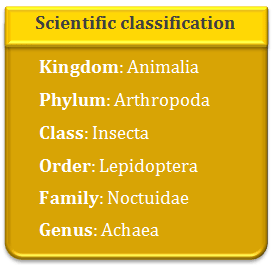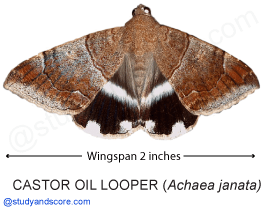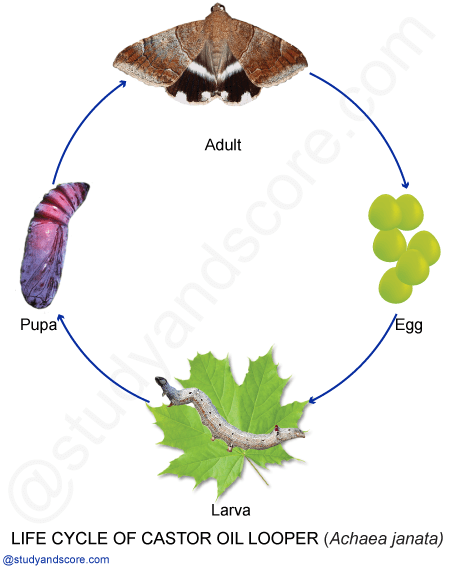
Castor semi-looper, Castor oil looper, Croton caterpillar
Castor semi-looper is widely spread throughout the tropical and subtropical Pacific regions. In 1944, it was first collected in Hawaiian island. This looper is a great damage causing pest of the oilseed crop and is distributed throughout the Indian Union. It seasonally occurs in the months from July to September.
It feeds on many different plant species but the preferred plants are Castor bean and crotons. Occasional hosts include banana, cabbage, Chinese cabbage, crown of thorns, Ficus, mustard, poinsettia, rose, sugarcane and tomato along with some legumes and Brassica species.

These loopers feed on leaves of hosts. Larvae eats off most of the leaves, leaving behind just the veins and petioles of affected plants during heavy population breakout.
The entire life cycle starting from egg and ending with adult takes place just within 48-50 days. The population of this moth varies from year to year in abundance.
Eggs: Eggs are hemispherical in shape, with color from pale to dark green. They measure 0.04 inch in diameter with deep markings radiating from a central point. The eggs are deposited in single or in masses. Eggs hatch in to larvae in 3 to 4 days.
Larvae: The body of the larva is divided into head, thorax and abdomen. Each thoracic segment and abdominal segment bears a pair of legs. They have some hairs on their body. It passes through 6 stages before pupation. The first stage caterpillars are transparent yellow or brown in color and measure about 0.125 inches in length. The next 4 caterpillar stages vary in colors from Orangish brown to greyinsh brown.

When fully grown, the caterpillars measure 2.5 inches in length. The greyish orange body develops a broken black stripe along the length on each side. Also white spots on the head and on the sides of the abdominal legs are developed. Also two bright red-orange spots are formed on the hump located at the back of the caterpillar. The duration of the larval stages is influenced by the amount of available food.
Pupa: Pupa is reddish brown in color measuring about 0.25 inches in length and covered by a silk cocoon. Caterpillars spin their cocoons both on and off the plants. The duration of the pupa stage is influenced by temperature. In warmer temperatures the development time is shorter whereas in cool temperature, the development time is longer.
Adults: The adult moth is 5/8th inch long with a wingspan of 2 inches. The forewings are brownish-gray and the hind wings are grey with a bright spots of black and white near the tips. Females start laying eggs 2 to 5 days after emerging from the pupa and lay an average of 1300 eggs during its lifetime. Eggs are laid during the night as moths are nocturnal.
Non-Chemical Control: The use of parasites which feed on croton caterpillars is proved to be efficient non-chemical control method. Introduction of egg parasite of Telenomus proditor into India was successful in killing caterpillars. Entomogenous microorganisms like fungi, bacteria and viruses also control the caterpillars. Especially bacterial agent like Bacillus thuringiensis has shown effect on croton caterpillar.
Chemical Control: Several chemical insecticides like pyrethrins and pyrethroids are effective against the croton caterpillar. Pyrethroid insecticides are more effective than natural pyrethrins.

- Share with your friends! -
Login to post your comment here...
- or with social Account -